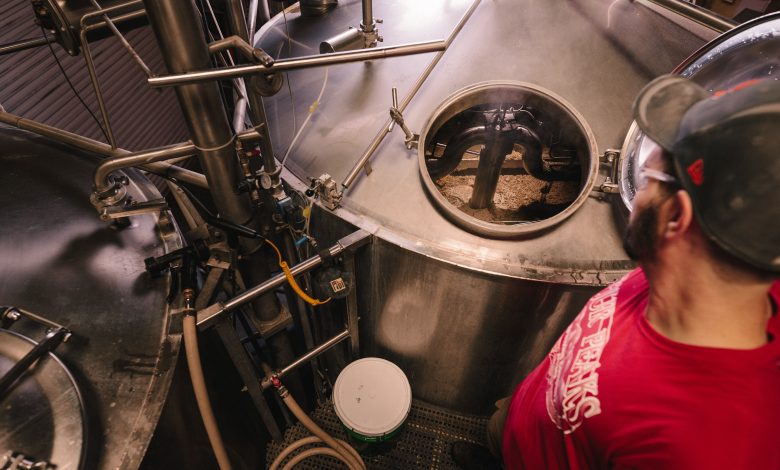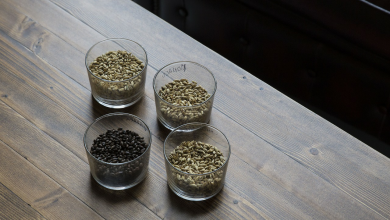The Beer Brewing Process Explained

Beer brewing is essentially a biotechnological process, meaning the action of brewing and the making of beer depend on numerous enzymes and their reactions; microorganisms, including yeast, release these enzymes.
The primary ingredients of beer are water, malted cereals (mainly barley), hops, and yeast. The final flavor profile of a beer is a result of the aromas generated by the interaction of ingredients and the various enzymatic reactions. In this article, we take an in-depth look at the beer brewing process.
Equipment Sanitization
Though technically, equipment sanitization does not form a part of beer brewing, it is a crucial step that is often undervalued. Cleaning and sanitizing are essential to ensure that your beer does not get spoiled.
A few points to keep in mind while cleaning your brewing equipment include:
- Check for residues and deposits at the bottom of beer-making containers after the end of every brewing process. Clean them immediately to prevent dirt build-up and drying.
- Clean equipment thoroughly instead of just rinsing them.
- Clean the equipment fresh after a process. With the surface still wet, cleaning becomes easier.
- Drain the equipment and air-dry them before storing them away. This method prevents the growth of microbes.
- Fermenting vessels and sometimes kegs may need frequent cleaning. This is because these pieces of equipment are in contact with wort more than others. As a result, they are prone to the build-up of beer stone (a compound that is a combination of protein and calcium oxalate).
Beer stone deposits can be removed by soaking the equipment in a specialized brewing cleanser and subsequent scrubbing. Some points to take note of while sanitizing equipment include:
- Bleach is a common sanitizer used by brewers. Pieces of brewing equipment are soaked in a solution of water and bleach. Equipment may then be rinsed with hot water to ensure elimination of off-flavors from chlorine.
- Many commercial sanitizers are available, designed exclusively for brewing equipment. Such sanitizers make the task extremely easy. Items can be soaked in the sanitizing solution or subject to the spray. Many sanitizers are no-rinse products, which means there is no need for additional rinsing of the equipment.
- Many brewers employ dry and steam heat methods for sanitization. Dry heat is based on oven-heating. Steam heating employs a dishwasher, autoclave, or pressure cooker for sanitization.
- Iodophor is another popular sanitizer. It is an iodine-based sanitizer that delivers hospital-grade sanitization. Pieces of equipment are soaked in a solution of iodophor and water. A soak time of a minimum of ten minutes is needed to achieve hospital-grade sanitization.
- Keep handy a sanitizer with a specification of 70% isopropyl alcohol for sanitizing your hands and surfaces instantly.

Malting
This is the first and basic step of beer brewing. Barley is the commonly used cereal for malting. Other cereals that are usually used include rye, sorghum, wheat, and oats. The purpose of malting is to activate the production of enzymes from the grain.
The type of malt used determines the color of the beer. For example, a malt that is roasted lightly gives a pale beer while heavily-roasted malt produces dark-colored beer.
The malting process consists of three phases. The process starts with the brewer soaking barley kernels in hot water. Barley kernels or the grains that are being used for beer brewing are crushed for the purpose. This phase is referred to as steeping. The time of soaking is about 40 hours.
The temperature of water depends on the type of malt and grain. Steeping helps the brewer extract color and flavor from the malt, which contributes to the final beer flavor.
The next phase is called germination. The malting process results in partial germination of the barley grains. The mixture of barley kernels and water undergoes aeration at regular intervals, which accelerates barley’s germination process. Brewers use a germination room where the grains are spread on the floor for about five days to promote germination.
The partial germination makes the contents of seeds available to the brewer for the brewing process. The following developments occur during the germination phase:
- The aleurone layer of the grain releases enzymes.
- New enzymes are also created.
- The key groups of enzymes that are activated during this process include proteases or peptidases, amylases, and beta-glucanases.
- All enzymes, including the above groups, contribute in different ways to the formation of beer.
- Peptidases/proteases, for example, break down the proteins in the grain’s endosperm and release free amino nitrogen.
- Beta-glucanases enable the new enzymes to interact with the grain’s endosperm by breaking down the wall of the endosperm.
- Amylases convert the starch in barley’s kernels into fermentable sugars.
The purpose of the entire germination process is to break down the grain’s endosperm carbohydrate and protein content into smaller lipids, amino acids, and carbohydrates.
An important measure in the germination process is the extent to which the endosperm wall is broken down. This is important because only then will the starch reserves be made available to the brewer. This change is referred to a modification in a brewer’s language.
A common method that a brewer uses to evaluate the extent of endosperm wall breakdown is to measure the endosperm’s acrospire. A malt grain that is fully modified will show an acrospire length that is 75 to 100 percent of the seed length.
The grain is allowed only partially to germinate. Complete germination will lead to the consumption of all starches released by the enzyme action by the growing plant. As a result, the brewer will lose access to these starches.
The brewer prevents complete germination through drying, which forms the next phase of malting.
In drying, grain kernels are heated and dried in a kiln. When grains dry, their rootlets (a part of the seed) and acrospires are eliminated. Drying prevents complete germination of the grain, stops interactions of enzymes within the kernels, and lowers the risk of spoilage of seeds (since fully-germinated seeds are of no use to the brewer).
Though drying eliminates several enzymes, it retains those that are needed for starch conversion. The amount of such enzymes present in the grain determines the capacity of the malt or grain for starch conversion. This measure also helps evaluate the impact that the malt or other grain will have on the final color and flavor profile of the beer.

Mashing
In mashing, grains are milled and then soaked in hot water. The mixture is maintained at pre-determined pH and temperatures. This customized environment provides the required conditions for enzymes in the grains to convert starch and protein within the grains into fermentable sugars.
The breakdown of grain contents happens gradually at different specified temperatures, in the following manner:
- The initial temperature commonly used by brewers for this process is 113 degrees F. This temperature activates proteases, which break down proteins into smaller amino acids and peptides. These compounds are essential, as they will form the primary source of nitrogen for yeast cells during fermentation.
- The mixture is then maintained at a temperature between 143.6 and 147.2 degrees F. At this temperature, starch undergoes gelatinization, which gives it a soft texture. The soft texture makes it easier for beta-amylases to separate maltose from starch.
- The remaining mixture is then set at 161.6 degrees F for 15 to 25 minutes. This results in a further breakdown of polysaccharides by alpha-amylases compounds.
- The final step is to increase the temperature of the mixture to 172.4 degrees F, which ends all enzymatic interactions.
Lautering
Also called filtering, this step involves the separation of grainy remains from the sugary liquid. This sugary liquid is sticky and is full of sugars released by the mashing process. This solution is called wort in a brewer’s language. The wort is then prepared for the next step – boiling.
Boiling
The Wort is added to a copper boiling vessel to initiate the boiling process. Hops and spices are added to the wort at this stage. The hops and spices are responsible for defining the final flavor and aroma profile of the beer.
Hops contain special compounds called alpha acids, which convert into iso-alpha acids, a type of isomers, as a result of boiling. These iso-alpha acids are responsible for the bitter taste in a beer.
Bitter hops, for example, have alpha acids in abundance. They are added to the boiling phase, usually at the beginning of the process. Aroma hops, on the other hand, have high concentrations of hop oil. Hop oil has over 200 compounds that give hops their characteristic flavor. Aroma hops are usually added to Wort toward the end of the boiling process.
Wort also undergoes the following during the boiling process:
- Protein loses its natural composition following denaturation, which leads to protein aggregation (clumping of such proteins).
- Elimination of unfavorable flavors such as dimethyl sulfide (DMS).
- Wort sanitization, which happens when Wwort is heated at high temperatures, is crucial to facilitate yeast fermentation

Fermentation
This is the process where all the action takes place, resulting in a beer with its own story. Fermentation refers to the simple action of conversion of fermentable sugars into ethanol and carbon dioxide. But numerous supplementary reactions happen during fermentation, which gives beer its unique taste and aroma.
The impact of yeast on beer is unique and deserves a special mention. This is because beer flavor and aroma depends on the strain of yeast used. With different strains, the reactions and interactions are different, which means the beer profile is different.
Some signature flavors that are imparted to beer through yeast cells include aromas of solvents (imparted by ethyl acetate), banana flavor (imparted by isoamyl acetate), and a pineapple flavor (imparted by ethyl hexanoate).
A fermentation process typically of the following steps:
Yeast is rehydrated, meaning dry yeast is converted into liquid yeast. Rehydration is strongly recommended because it reduces osmotic shock on yeast cells.
Osmotic stress occurs as a result of sudden changes in water activity during fermentation or an increase in sugar levels during the process. Yeast cells may react by shrinking or swelling, either of which decreases the survival rate of the cell. It is, therefore, important to arrest, or at least reduce, the occurrence of such stress.
Rehydration also promotes good dispersion of yeast cells, which is important to derive a beer of desired properties.
The rehydrated yeast is introduced into the fermentation vessel
Cooled wort is then introduced into the fermenting vessel. The method of wort introduction is aggressive – pouring causes churn and splashes in the vessel. When introduced in this way, yeast is exposed to the air from where it derives the required oxygen from supporting its growth.
It should be noted that this is the only phase in the entire brewing process when the beer comes into contact with air for oxygen. All other transfers are performed through sanitized siphons with only negligible disturbance to the flow and minimal air contact.
Some brewers remove hops during this phase through the use of strainer, but it is not necessary.
The fermenting vessel is then airlocked tightly with a lid. The vessel is stored in a location that has a stable temperature of 65 to 70 degrees F. A temperature above 80 degrees F is not recommended, as it alters the flavor of the beer. The vessel is left in the location, undisturbed, for two weeks.
Left undisturbed this way, the solution in the vessel undergoes fermentation. The first evidence that shows fermentation is underway is the presence of bubbles in the airlock. The fermentation continues for two to four days.
The intensity of the activity decreases after two days. By this time, most of the malt sugars will be consumed by the yeast. Bubbling reduces after two days, but fermentation continues.
The fermentation that occurs with the first 10 to 14 days is described as primary fermentation. The end product of this process is green beer.
After this duration, a majority of the yeast is removed from the fermenting vessel, and the green beer is moved to a maturation tank.
The beer is stored in the maturation tank at lower temperatures for a specified interval, depending on the type of beer you are producing. The lower temperatures typically range from -30.2 to 41 degrees F.
If you want an ale beer, the maturation tank is maintained at lower temperatures for several days. In the case of lager beers, the duration is a couple of weeks.
The yeast remaining in the green beer continues to be active in the maturation tank. These yeast cells can produce more ethanol and carbon dioxide and reduce unfavorable flavors of compounds such as diacetyl (this compound gives off a rancid buttery aroma).
Breweries usually use their proprietary strains of yeast to produce their signature beer styles. Two types of strains that are commonly used are the top-fermenting and bottom-fermenting yeasts.
With top-fermenting yeast cells, the fermentation process takes place on the top of the brew. These yeast cells are employed for the production of ale beers. Bottom-fermenting yeasts are used for lager beers. Fermentation takes at the bottom of the fermenting vessel with these cells.
Though fermentation usually uses only a specific type of yeast cells, brewers may use a mixed fermentation process for specific kinds of beer. Mixed fermentation uses different yeast types, which appear in a series during fermentation and leave back their unique flavor and aroma.
Such mixed fermentation involving different yeast strains adds a complexity to the beer flavor. For example, a beer may produce a mixed flavor profile, combining spicy, metallic, smoky, and barnyard-like aromas.

Bottling and Storage
Once fermentation is complete, the beer is ready to be put into casks or bottles. Beers in casks are the least processed beer types. In case beers need to be transferred to bottles, kegs, or cans, they need additional processing, including carbonation. Additional processing depends on the type of beer that has been produced.
In case beers are being bottled, it is crucial to sanitize the containers. They need to be cleaned first and then sanitized. If old bottles are being used, they need to be checked for the presence of mold or dirt deposits. Bottle caps also need to be sanitized. One common way that brewers use to sanitize bottle caps is to immerse them in a sanitizing solution.
The following steps are followed in cases where the beer needs additional processing:
- A priming solution is prepared by boiling the pre-determined amount of corn sugar or cane sugar to water. The vessel is covered after boiling and allowed to cool.
- The priming solution is introduced into a sanitized container. The beer is then introduced into the container.
The beer should not be introduced aggressively with a splash into the vessel. Instead, it needs to be poured gently with the siphon positioned beneath the beer surface even as the remaining beer pours in. This prevents the risk of beer aeration (coming into contact with air and thereby oxygen).
This causes a swirling motion, which is enough for the priming solution to mix with the beer evenly. Let the solution be for about 30 minutes.
- The beer is then bottled carefully. Bottles and their caps are sanitized before this process. The bottles are capped. They are stored away from light, in a dark room at warmer temperatures, preferably in the 65 to 75 degree F range.
- Allow two weeks of time for the beer to carbonate. The bottles will show a deposit of thin yeast layer at the bottom.

Tasting the Beer!
It is now time to taste the delicious beer!
A month after bottling, the beer is ready to be tasted. In the two weeks of carbonation, yeasts present in the bottle consume the priming sugar and release carbon dioxide. This carbon dioxide carbonates the beer.
If you open the bottle before two weeks, carbonation is interrupted and yields what is called in a brewer’s language a “young beer.” It is important to allow the beer to take the required time for carbonation. This duration gives the flavors in the beer enough time to balance and mix well, resulting in a well-balanced beer.
Being well-informed about the beer brewing process keeps you well-prepared, reduces the risk of costly errors, and results in the desired flavor profile.



